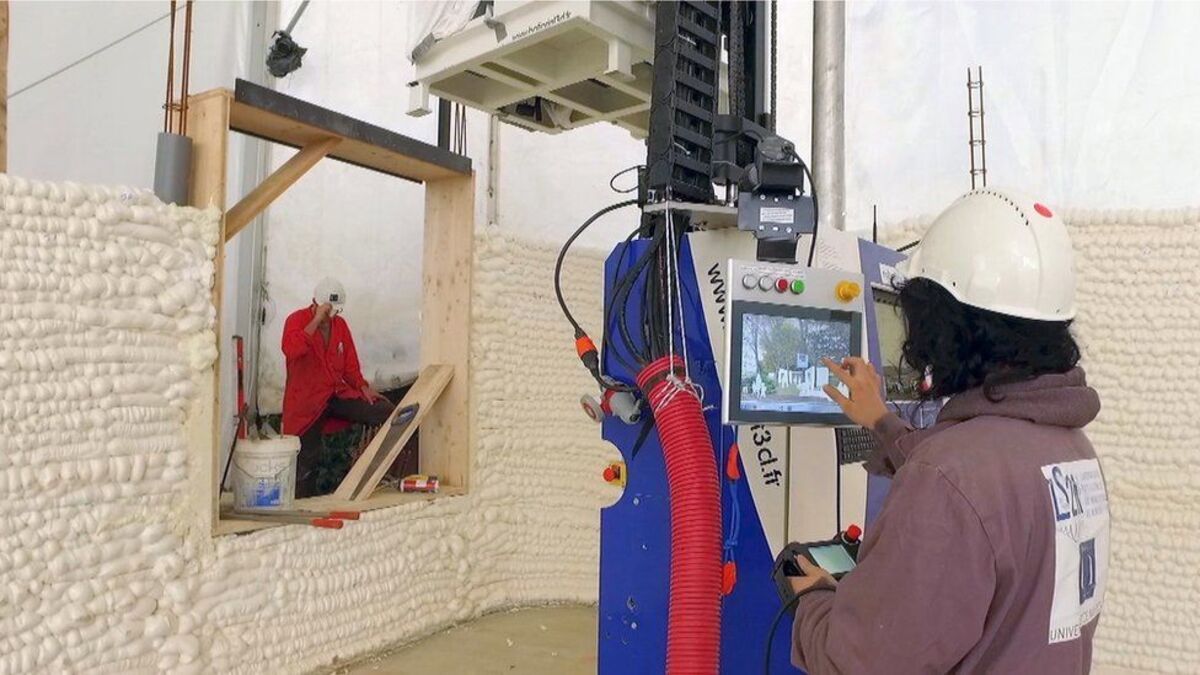Imagine if your home could be built in days. 3D printing has the potential to build your house from the ground up faster and for less money than a conventional home which means amongst other things, no more smoothing concrete by hand.
The technology can physically produce a product of almost any shape based on a digital image. It works by overlapping thin layers of a material, not unlike icing a cake with a piping bag. And with it, you can build almost anything your mind can imagine, from children’s toys to prosthetics, to automotive parts.
The same technology now has the potential to disrupt the entire construction industry. Europe’s largest 3D printed residence is currently under construction in the German state of Bavaria. A three-story, 380 square meters, 4,000 square foot apartment complex made of concrete. While it normally takes five people five days to build the ground floor, it took two people just one day to do the work with 3D printing. Saving time and cutting costs.
Further reductions are found in minimizing waste because the printer knows exactly how much material to use whereas today, most walls in a house have the same thickness regardless of whether it’s structurally needed or not.

This is not the first build of its kind In 2018, the Ramdanis became the first family ever to move into a 3D printed home as part of a social housing project in the northwestern French city of Nantes. This house took only 54 hours to print and cost 20% less than a comparable home built the traditional way.
In the United States, ICON envisions similar savings. The Texas-based company has partnered with a non-profit to build homes for the homeless in Austin and affordable housing in Mexico. Using the latest technology, it can print a 400-500 square foot house in just 24 hours. After building two dozen of the small 3D houses, ICON is now building much larger homes for the going market rate.
But its most ambitious project is out of this world. NASA has given ICON funding to research and develop a technique for constructing living quarters on the moon by using raw materials. The company is experimenting with a substance resembling lunar regolith, the debris that covers the moon’s surface.
Building in such an environment will take some ingenuity. This is how it could be done. The dome of the habitation capsule is inflated and acts as a support structure – just like scaffolding here on Earth. Robots scoop up the regolith, then print a shell that’s light, yet strong enough to protect against radiation, meteorites, and temperature fluctuations.
The same template could be used for Martian habitats which would also rely on natural materials found there. AI Spacefactory plans to create egg-shaped homes based on this prototype called MARSHA, which won NASA’s space habitat competition in 2019. The company says MARSHA could be built using basalt fibre extracted from Martian rocks and renewable bioplastic processed from plants grown on the red planet. According to the firm, the material has been tested to be stronger and more durable than concrete.
Building on Mars is still a long way off of course. But, a similar dwelling is already available for rent closer to home, in upstate New York. There are plans to recycle it and re-create more advanced versions across the globe.
Although 3D printing is spreading, there are still limitations to overcome. Some printers don’t work well when temperatures drop below freezing. Errors in the digital model could result in major issues on site. Certain materials, including wood, can’t be printed. And printers can’t do all the work…yet.
Construction workers are still needed to add things like a roof but overall the new technologies being used on building sites in the future will require a lot less manual labour.
A robot recently did all the brickwork for a three-bedroom house under construction in northern England. It’s not all bad news for the workforce, however, as new, higher-skilled jobs such as modelling can be created.
One California company, Mighty Buildings, compares the 3D construction industry revolution to the current transformation underway in the auto industry with Tesla leading the way with its advanced technology.
Mighty Building’s printed studios start at $183,000 in a state where the median home price is $700,000. They’re produced in the company’s Oakland factory using a light stone material that hardens when exposed to UV light and is more thermally resistant than concrete. Once fully completed, they’re delivered to the site, and plopped down on an existing backyard or soon, on top of a garage. The company also has plans to roll out single-family homes in the near future.
As the technology improves, so does the ability to print much larger buildings, like the two-story, 7,000 square foot administrative office in Dubai -the largest 3D printed building in the world. The Middle Eastern city is fast becoming an international printing hub and expects to have a quarter of all new buildings 3D printed by 2030.
The construction industry has traditionally been slow when it comes to embracing new technology. But 3D printing may prove hard to resist and could quickly become mainstream, providing more and better housing options for people in this world and beyond.
The big question is: would you want to live in a 3D printed home?
